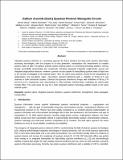Gallium arsenide (GaAs) quantum photonic waveguide circuits
Abstract
Integrated quantum photonics is a promising approach for future practical and large-scale quantum information processing technologies, with the prospect of on-chip generation, manipulation and measurement of complex quantum states of light. The gallium arsenide (GaAs) material system is a promising technology platform, and has already successfully demonstrated key components including waveguide integrated single-photon sources and integrated single-photon detectors. However, quantum circuits capable of manipulating quantum states of light have so far not been investigated in this material system. Here, we report GaAs photonic circuits for the manipulation of single-photon and two-photon states. Two-photon quantum interference with a visibility of 94.9±1.3% was observed in GaAs directional couplers. Classical and quantum interference fringes with visibilities of 98.6±1.3% and 84.4±1.5% respectively were demonstrated in Mach-Zehnder interferometers exploiting the electro-optic Pockels effect. This work paves the way for a fully integrated quantum technology platform based on the GaAs material system.
Citation
Wang , J , Santamato , A , Jiang , P , Bonneau , D , Engin , E , Silverstone , J W , Lermer , M , Beetz , J , Kamp , M , Höfling , S , Tanner , M G , Natarajan , C M , Hadfield , R H , Dorenbos , S N , Zwiller , V , O'Brien , J L & Thompson , M G 2014 , ' Gallium arsenide (GaAs) quantum photonic waveguide circuits ' , Optics Communications , vol. 327 , pp. 49-55 . https://doi.org/10.1016/j.optcom.2014.02.040
Publication
Optics Communications
Status
Peer reviewed
ISSN
0030-4018Type
Journal article
Description
This work was supported by the European FP7 project Quantum Integrated Photonics (QUANTIP), the Engineering and Physical Sciences Research Council (EPSRC), the European Research Council (ERC)Collections
Items in the St Andrews Research Repository are protected by copyright, with all rights reserved, unless otherwise indicated.

